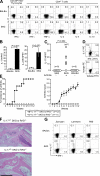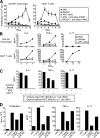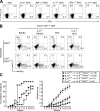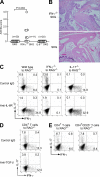T cell self-reactivity forms a cytokine milieu for spontaneous development of IL-17+ Th cells that cause autoimmune arthritis
- PMID: 17227914
- PMCID: PMC2118414
- DOI: 10.1084/jem.20062259
T cell self-reactivity forms a cytokine milieu for spontaneous development of IL-17+ Th cells that cause autoimmune arthritis
Abstract
This report shows that highly self-reactive T cells produced in mice as a result of genetically altered thymic T cell selection spontaneously differentiate into interleukin (IL)-17-secreting CD4+ helper T (Th) cells (Th17 cells), which mediate an autoimmune arthritis that clinically and immunologically resembles rheumatoid arthritis (RA). The thymus-produced self-reactive T cells, which become activated in the periphery via recognition of major histocompatibility complex/self-peptide complexes, stimulate antigen-presenting cells (APCs) to secrete IL-6. APC-derived IL-6, together with T cell-derived IL-6, drives naive self-reactive T cells to differentiate into arthritogenic Th17 cells. Deficiency of either IL-17 or IL-6 completely inhibits arthritis development, whereas interferon (IFN)-gamma deficiency exacerbates it. The generation, differentiation, and persistence of arthritogenic Th17 cells per se are, however, insufficient for producing overt autoimmune arthritis. Yet overt disease is precipitated by further expansion and activation of autoimmune Th17 cells, for example, via IFN-gamma deficiency, homeostatic proliferation, or stimulation of innate immunity by microbial products. Thus, a genetically determined T cell self-reactivity forms a cytokine milieu that facilitates preferential differentiation of self-reactive T cells into Th17 cells. Extrinsic or intrinsic stimuli further expand these cells, thereby triggering autoimmune disease. Intervention in these events at cellular and molecular levels is useful to treat and prevent autoimmune disease, in particular RA.
Figures





References
-
- Ulmanen, I., M. Halonen, T. Ilmarinen, and L. Peltonen. 2005. Monogenic autoimmune diseases-lessons of self-tolerance. Curr. Opin. Immunol. 17:609–615. - PubMed
-
- Sakaguchi, N., T. Takahashi, H. Hata, T. Nomura, T. Tagami, S. Yamazaki, T. Sakihama, T. Matsutani, I. Negishi, S. Nakatsuru, and S. Sakaguchi. 2003. Altered thymic T-cell selection due to a mutation of the ZAP-70 gene causes autoimmune arthritis in mice. Nature. 426:454–460. - PubMed
-
- Hata, H., N. Sakaguchi, H. Yoshitomi, Y. Iwakura, K. Sekikawa, Y. Azuma, C. Kanai, E. Moriizumi, T. Nomura, T. Nakamura, and S. Sakaguchi. 2004. Distinct contribution of IL-6, TNF-alpha, IL-1, and IL-10 to T cell-mediated spontaneous autoimmune arthritis in mice. J. Clin. Invest. 114:582–588. - PMC - PubMed
-
- Chan, A.C., M. Iwashima, C.W. Turck, and A. Weiss. 1992. ZAP-70: a 70 kd protein-tyrosine kinase that associates with the TCR zeta chain. Cell. 71:649–662. - PubMed
-
- Yoshitomi, H., N. Sakaguchi, K. Kobayashi, G.D. Brown, T. Tagami, T. Sakihama, K. Hirota, S. Tanaka, T. Nomura, I. Miki, et al. 2005. A role for fungal β-glucans and their receptor Dectin-1 in the induction of autoimmune arthritis in genetically susceptible mice. J. Exp. Med. 201:949–960. - PMC - PubMed
Publication types
MeSH terms
Substances
LinkOut - more resources
Full Text Sources
Other Literature Sources
Medical
Molecular Biology Databases
Research Materials
Miscellaneous

